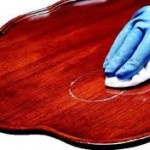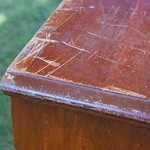Water Rings
 Water ring stains on wood finishes can be easily removed by ironing them out. Just place a thick piece of cloth over the water ring and press it with a warm iron. Rub the warm iron over the cloth-covered water ring until it disappears.
Water ring stains on wood finishes can be easily removed by ironing them out. Just place a thick piece of cloth over the water ring and press it with a warm iron. Rub the warm iron over the cloth-covered water ring until it disappears.
If the water ring is extremely stubborn, rub it with lemon or orange oil. Let the oil set on the water ring for several hours or overnight, and wipe off the excess oil. The water ring should be much less apparent or it may be completely gone.
Another remedy for water rings on furniture is a mixture of white toothpaste and mayonnaise. Just rub the water ring with an equal mixture of white toothpaste and mayo and wipe off any leftovers. Rub the area with orange oil or lemon oil, and the water ring should be gone.
Wood finishes that have been damaged by milk-based products can be cleaned and repaired by rubbing it with a soft rag and ammonia or a little silver polish. Just cover your index finger with a rag and dip it in either straight ammonia or a dab of silver polish. Rub the area to remove the stain and follow up by polishing with lemon oil or orange oil.
Dents
Wood dent fillers work well to repair small dents, but they rarely match the color of wood furniture. Before using wood filler, try a trick using your iron. Begin by removing the finish on the dent using the appropriate wood stripper and a cotton swab. Be careful not to get solvent anywhere else on the furniture. Place a clean damp rag over the dent, and lightly press the tip of the iron over the dented area for several seconds. Dry the wood surface with a clean cloth. Lightly sand the dented area, and refinish it to match the wood stain and varnish.
Scratches
 Very light or minor scratches in the varnish sometimes disappear when rubbed with furniture polish or oil. Almond oil sticks are also wonderful for repairing light scratches. They often just disappear. Deeper scratches that have removed the stain are also sometimes successfully covered using furniture repair sticks or even iodine. If these methods of scratch repair are unsuccessful, try a couple of methods often used by professionals.
Very light or minor scratches in the varnish sometimes disappear when rubbed with furniture polish or oil. Almond oil sticks are also wonderful for repairing light scratches. They often just disappear. Deeper scratches that have removed the stain are also sometimes successfully covered using furniture repair sticks or even iodine. If these methods of scratch repair are unsuccessful, try a couple of methods often used by professionals.
Light scratches or abrasions in the varnish of wood can often be blended in using a drop of lacquer thinner mixed with denatured alcohol. Before trying this method, test a hidden area on the furniture to see how the solvent affects the varnish. You only want to soften it, not remove it. If the test gives satisfactory results, proceed with repairing the scratches or abrasions. Use a very small, soft fine-tipped paintbrush to carefully apply the solvent and blend in the varnish that surrounds the damaged area. Move the brush diagonally to achieve the best results. After the area is smooth, allow it to dry, and apply a coating of lemon or orange oil.
When scratches are deep and can’t be repaired with simple repair methods, use a solvent following the same method above, and make sure the type of solvent you use will not completely remove the finish. Heat the blade of a pallet knife or another thin flat-edged metal tool. Place the end of a matching wood fill stick or varnish stick against the hot blade. As it melts, spread the wood filler into the scratch and level the surface.


